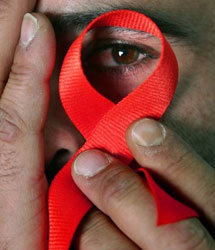 |
 |
 |
 News from Around the Americas | December 2005 News from Around the Americas | December 2005  
HIV Cases Pass Record 40 Million Mark: UN
 Agence France-Presse Agence France-Presse


| | A Jordanian citizen living with HIV covers his face to avoid being identified at a Voluntary Counciling and Testing Center in Aman. About 40 million people world wide are now infected with HIV, the virus that causes AIDS. Some 3 million are expected to die of AIDS this year. (Photo: Ali Jarekji / Reuters) |
Progress has been made in tackling HIV infection in key African countries, but five million people were infected worldwide in 2005 to take the estimated total beyond 40 million, a UN report said.

The five million cases recorded in 2005 was "the highest number of people newly infected (in a year) since the beginning of the epidemic," Peter Piot, executive director of the UNAIDS programme, told reporters in New Delhi.

The AIDS epidemic claimed 3.1 million lives during the year, more than half a million of them children, the report said Monday.

"The total number of people living with the human immunodeficiency virus (HIV) reached its highest level, an estimated 40.3 million" up from 37.5 million in 2003, said the AIDS Epidemic Update 2005, released here.

The report that came ahead of World AIDS Day on December 1 noted that "the overall number of people living with HIV continued to increase in all regions of the world except the Caribbean."

The survey warned that growing epidemics were underway in eastern Europe, Central Asia and east Asia and that the spread of HIV/AIDS was intensifying in southern Africa.

Sub-Saharan Africa accounted for 64 percent of the new infections, taking the number of cases there to an estimated 25.8 million.

"HIV stigma and the resulting actual or feared discrimination have proven to be perhaps the most difficult obstacles to effective HIV prevention," the report said, and these factors "created an ideal climate" for the spread of the epidemic.

Piot said there was a large gap in HIV prevention. Of people living with HIV, "only one in 10 has been tested and knows that he or she is infected."

Only "one in 10 Africans and one in seven Asians in need of anti-retrovirals were receiving it in mid-2005."

But in some parts of Africa there were "hopeful signs" of declining national HIV prevalence. Infection levels were dropping in Zimbabwe, Uganda and Kenya, the report said.

"In the two African countries of (Zimbabwe and Kenya) the declines in HIV rates have been due to changes in behavior. In other words, HIV prevention efforts are working," the report said.

Piot said the 2005 report "had some very welcome news namely that in several countries HIV infection rates have fallen recently."

"This news is especially encouraging because these countries are in regions most severely affected by AIDS - sub-Saharan Africa and the Caribbean," Piot said.

"But the reality is that the AIDS epidemic continues to outstrip global and national efforts to contain it. It is clear that a rapid increase in the scale and scope of HIV prevention programmes is urgently needed," he said urging "an unprecedented response."

It was an "unprecedented epidemic both as a crisis today and as a threat to the future ... at this juncture where success is within sight we have to intensify our efforts more than ever before," he said.

Mother-to-child transmission was one of the causes for new infections in sub-Saharan Africa, the report said, predicting about 35 percent of all children born to HIV-positive women would contract the virus.

Levels of knowledge about safe sex and HIV remain low in many countries, especially in many sub-Saharan nations, and notably in Cameroon, Nigeria, Senegal and Uganda.

Two-thirds or more of young women between 15-24 years lacked comprehensive knowledge of how HIV is transmitted, the report said.

A major poll in the Philippines two years ago found more than 90 percent of respondents believed that HIV could be transmitted by sharing a meal with an affected person.

The report said access to cheaper antiretroviral drugs had improved markedly in the past two years with more than one million people in low-and middle-income countries living longer and having better lives.

"Treatment coverage in ... Argentina, Brazil, Chile and Cuba now exceeds 80 percent," the report said, adding that better access to antiretrovirals had averted an estimated 250,000 to 350,000 deaths.

"We can now see the clear benefit of scaling up HIV treatment and prevention together and not as isolated interventions," World Health Organization (WHO) Director-General Lee Jong-wook said. | 
 | |
 |



